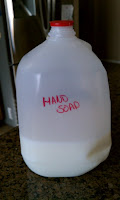You can thank my hubs for that CORNY title :p. He is guest posting today for me on the subject of compost. The Friday Find is FREE or super cheap (depending on your city) compost bins from the city!
Give him some love in the comments so he does this again, he's got plenty of corny post titles ready to go ;).
=============================
Gardening in the desert is a challenge. The soil, if you can
call it that, is pretty much completely lacking in nutrients. So we started our
garden in a raised bed. We bought some organic soil mix to fill the bed and had
some success in growing some vegetables. But we knew we’d need to keep
replenishing the nutrients so we turned to composting.
Composting has lots of benefits, but the biggest is that you
can reduce the waste you send to landfill while creating nutrient-rich
fertilizer for your garden. Almost any organic plant material can be used to
create compost. Fruit and vegetable scraps, lawn and tree trimmings, whatever
you have. Ideally, you need to have a good mix of “greens” – nitrogen-rich
ingredients such as vegetable scraps – and “browns” – carbon-rich ingredients
like leaves and paper. But it’s not rocket science, if you can’t get a 50/50
mixture, just try your best.
Here is a list of some things you can compost:
Greens
·
- Vegetable and fruit scraps
·
- Coffee grounds and filters
·
- Tea bags (make sure you remove any staples
first)
·
- Grass
·
- Horse or cow manure
Browns
·
- Leaves
·
- Paper products, including newspaper. Careful
though – some colored inks are made with heavy metals and are not good for you
or your garden so check the source!
·
- Pine needles
·
- Hay or Straw
We have a small ceramic container that we keep in our
kitchen to collect our scraps in. As it gets full I take it out to one of our
outside bins.
There are lots of options available for storing your
compost. Open bins, rotating drums, and everything in between. We originally
bought a plastic bin from Amazon (
Achla Designs CMP-05 Spinning Composter Horizontal
) that was easy to rotate. We did this for a few
reasons. First, compost needs to be mixed up from time to time to help aerate
the mixture and stir up the microbes that are breaking your compost down. We
thought we would be more likely to keep doing this if the compost was in
something easy to rotate. Secondly, being in the desert, we thought it would
help keep the mix moist. If the compost dries out it won’t decompose very
quickly.
As we filled the bin, we realized we would want a second one
to start filling since the compost in the drum was nearly ready to use. We
happened to find out that our city offers old trash bins that they have
cleaned, cut the bottom off of, and drilled several holes into for aeration.
Best of all, they were free!
I cleared a spot next to our rotating bin and we started
throwing our waste in there. Amazingly, our new bin is working out *much*
better than the drum. The drum has a tendency to hold *too* much water in it,
especially if rainwater gets in there. Since it’s a fairly closed system, there
is no drainage. And let me tell you, compost that gets too wet and sits for a
while gets
funky. I ended up having
to leave the sliding lid of the drum open for a while to dry out.
The new
bin has enough aeration to keep from getting too wet, while still being closed
enough to retain some moisture. I have an old floor scraper that I use to mix
things up (I do this every time I empty our compost into the bin, it only take
a few seconds) and as a bonus, the end is sharp enough to break larger chunks
of material up.
 |
| The bin from the city |
 |
| our compost pile in the bin |
After using the bin we got from the city for a few months, I
can honestly say I regret spending the money on the one from Amazon. The modified
garbage container was FREE, and the compost is breaking down much, much faster
than in the rotating drum. But if you’d rather have something that’s a bit
nicer looking then there’s no problem with a professionally made product.
There are a ton of good links out there about building your
own bin and what you can and can’t compost. Here are some that I’ve used before:



































